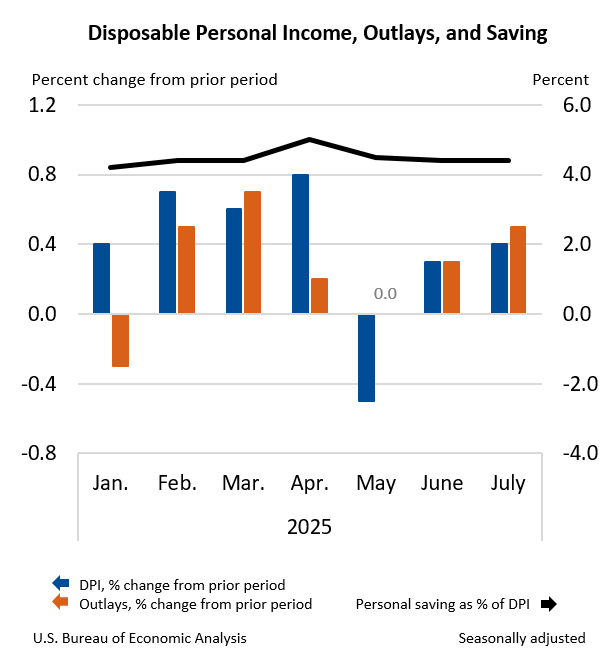Bureau of Economic Analysis
Personal Income and Outlays, July 2025
Personal income increased $112.3 billion (0.4 percent at a monthly rate) in July, according to estimates released today by the U.S. Bureau of Economic Analysis. Disposable personal income (DPI)—personal income less personal current taxes—increased $93.9 billion (0.4 percent) and personal consumption expenditures (PCE) increased $108.9 billion (0.5 percent). Personal outlays—the sum of PCE, personal interest payments, and personal current transfer payments—increased $110.9 billion in July. Personal saving was $985.6 billion in July and the personal saving rate—personal saving as a percentage of disposable personal income—was 4.4 percent.
Principal Federal Economic Indicators
Noteworthy
- 2025 News Release Schedule
- Innovation at BEA
- 2025 Annual Updates
- Distribution of Personal Income Nowcast
- New! Services Trade Data for More Countries
- Data Tool: Trade in Value Added
- Updated: RIMS II Regional Multipliers
- Arts and Culture
- Space Economy
- FDI Now in State BEARFACTS
- Quick Guide: Price Indexes
The Latest
U.S. International Trade in Goods and Services, March 2017
The U.S. Census Bureau and the U.S. Bureau of Economic Analysis, through the Department of Commerce, announced today that the goods and services deficit was $43.7 billion in March, down $0.1 billion from $43.8 billion in February, revised. March exports were $191.0 billion, $1.7 billion less than February exports. March imports were $234.7 billion, $1.7 billion less than February imports.
Real Consumer Spending Rises in March
Personal income increased 0.2 percent in March after increasing 0.3 percent in February. Wages and salaries, the largest component of personal income, increased 0.1 percent in March after increasing 0.5 percent in February.
Personal Income and Outlays, March 2017
Personal income increased $40.0 billion (0.2 percent) in March according to estimates released today by the Bureau of Economic Analysis. Disposable personal income (DPI) increased $35.0 billion (0.2 percent) and personal consumption expenditures (PCE) increased $5.7 billion (less than 0.1 percent). Real DPI increased 0.5 percent in March and Real PCE increased 0.3 percent. The PCE price index decreased 0.2 percent.
GDP Increases in First Quarter
Real gross domestic product (GDP) increased 0.7 percent in the first quarter of 2017, according to the “advance” estimate released by the Bureau of Economic Analysis. In the fourth quarter of 2016, real GDP increased 2.1 percent.
Gross Domestic Product, 1st quarter 2017 (advance estimate)
Real gross domestic product (GDP) increased at an annual rate of 0.7 percent in the first quarter of 2017 (table 1), according to the "advance" estimate released by the Bureau of Economic Analysis. In the fourth quarter of 2016, real GDP increased 2.1 percent.
New Data Project: Measuring the Economic Impact of Outdoor Recreation
We Want to Hear from You
Members of the public, private industry, state and local governments, non-profit organizations, and other interested parties are invited to provide feedback on the development of a new set of statistics that will provide information on economic activity associated with the outdoor recreation segment of the United States economy.
Finance and Insurance Led Growth in the Fourth Quarter
Finance and insurance; retail trade; and professional, scientific, and technical services were the leading contributors to the increase in U.S. economic growth in the fourth quarter of 2016. Overall, 19 of 22 industry groups contributed to the 2.1 percent increase in real GDP in the fourth quarter.
Gross Domestic Product by Industry, 4th quarter 2016
Finance and insurance; retail trade; and professional, scientific, and technical services were the leading contributors to the increase in U.S. economic growth in the fourth quarter of 2016. According to gross domestic product (GDP) by industry statistics released by the Bureau of Economic Analysis, 19 of 22 industry groups contributed to the overall 2.1 percent increase in real GDP in the fourth quarter.
New Data Showcase Economic Impact of Arts and Culture in U.S. and States
Sure, Broadway and Hollywood employ lots of creative people. But when it comes to artistic and cultural work, not all the action is on the coasts. New data show arts and culture account for a larger share of jobs in Wyoming, Utah and Colorado than they do nationally.
For the first time, the Bureau of Economic Analysis has produced statistics spotlighting the economic impact of arts and cultural activities in each state and the…
Arts and Cultural Production Satellite Account, U.S. and States 2014
New State Data Show Employment in These Industries Rises in 24 States
Arts and cultural economic activity nationwide grew an inflation-adjusted 1.9 percent in 2014, according to new statistics released by the Bureau of Economic Analysis. That compares with a 2.4 percent increase in real value added from all arts and culture industries for 2013 (table 1). Arts and cultural economic activity accounted for 4.2 percent…




